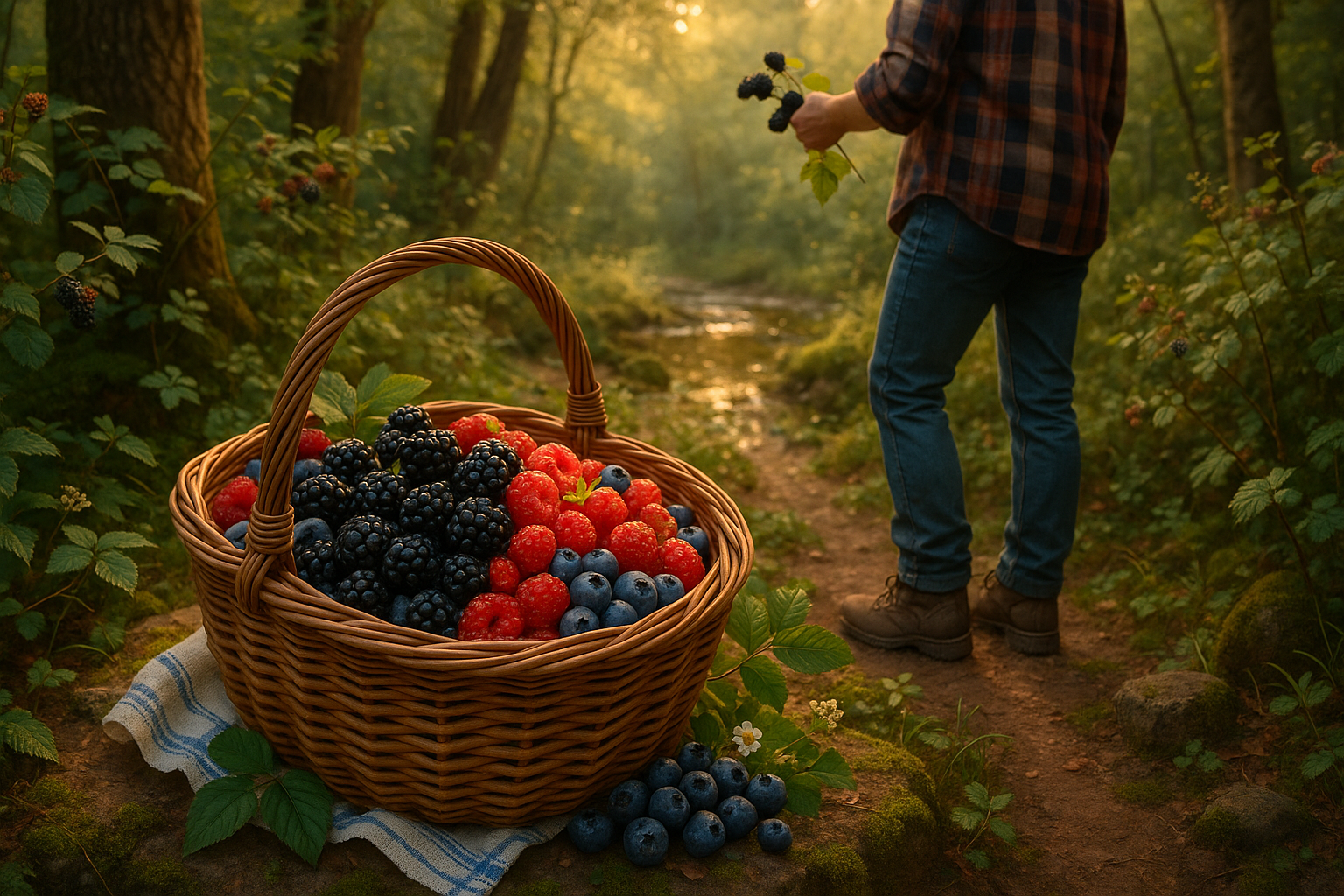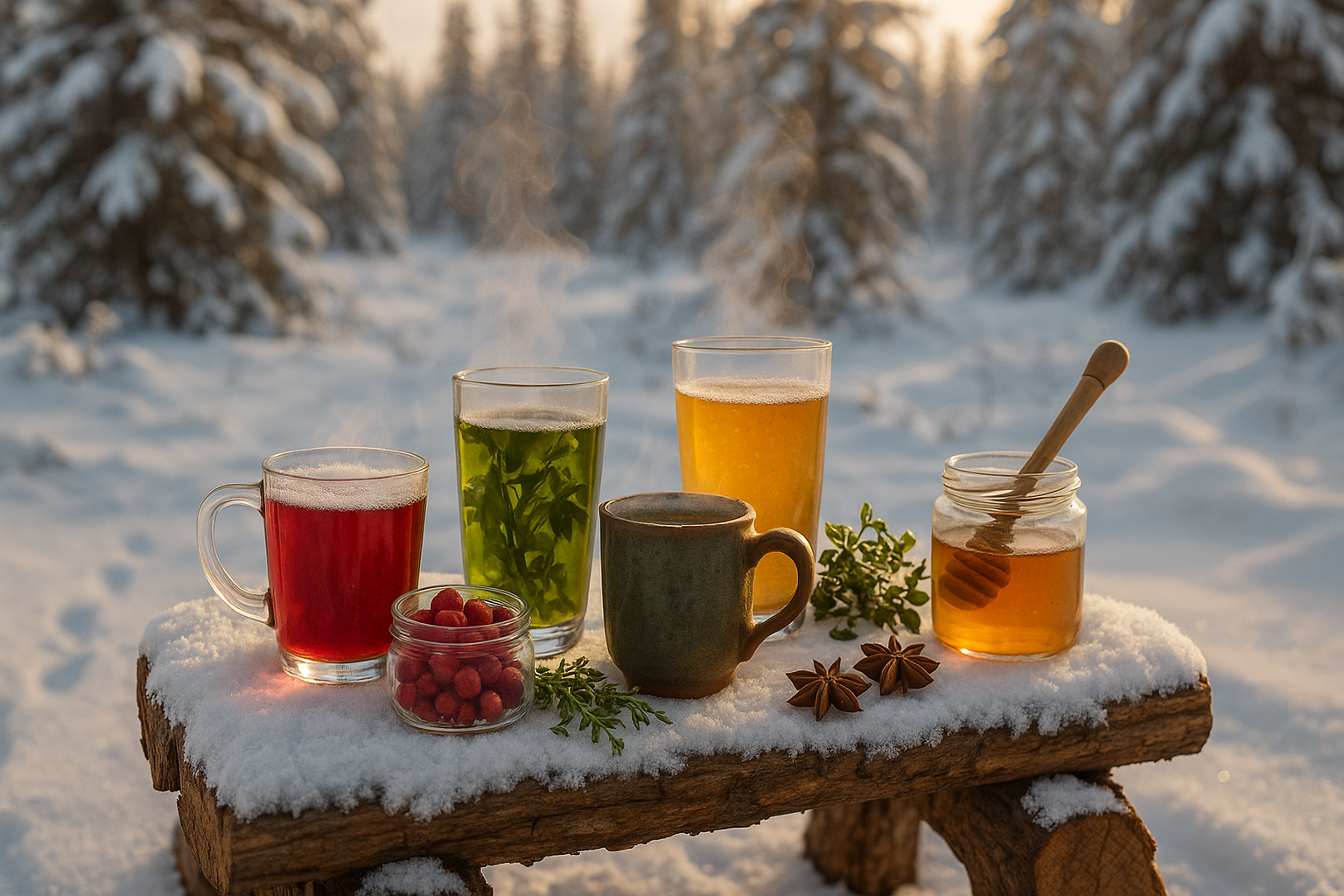Imagine stepping into a lush, vibrant forest, the sun peeking through the canopy as you tread softly on the leaf-strewn path. The air is fresh, filled with the earthy aroma of nature’s bounty. Here, amidst the verdant green, lies a world of hidden treasures—berries and wild fruits waiting to be discovered and savored. 🌿✨ Foraging is not just a hobby; it’s an adventure, a journey back to our roots, and a sustainable way to enjoy nature’s offerings.
In recent years, foraging has experienced a resurgence. More people are drawn to the allure of picking their own food directly from nature. This interest is not only a reflection of a desire to eat organic and fresh produce but also a yearning for a deeper connection with the environment. As you embark on this guide to foraging for berries and wild fruits, you’ll find that it’s more than just a seasonal activity—it’s a lifestyle choice that promotes sustainability, health, and well-being.
The thrill of foraging lies in the unexpected discoveries—like stumbling upon a hidden patch of plump blueberries or the tangy taste of freshly picked raspberries. 🍇 These experiences are not only rewarding but also educational. Foraging teaches us to identify edible plants, respect nature’s cycles, and appreciate the incredible variety of fruits that exist beyond what we see in supermarkets.
This comprehensive guide will equip you with the knowledge and skills to start your own foraging adventures. We’ll delve into the different types of berries and wild fruits that can be found in various habitats, from the familiar blackberries and strawberries to the lesser-known huckleberries and elderberries. Each of these has its own unique flavor profile and nutritional benefits, which we’ll explore in detail.
Understanding the Basics of Foraging
Before you set out on your foraging journey, it’s crucial to understand the basics. This includes knowing where to look, the best seasons for different fruits, and most importantly, how to forage safely and ethically. We’ll discuss the importance of sustainable harvesting practices, ensuring that the natural environment remains undisturbed for future generations.
Identifying Edible vs. Inedible
One of the biggest challenges in foraging is distinguishing between edible and inedible, or even poisonous, fruits. 🍒 We’ll provide tips on how to correctly identify fruits, supported by descriptions, images, and key characteristics to look for. This section will empower you with the confidence to forage safely and enjoyably.
The Health Benefits of Wild Fruits
Wild fruits are often packed with more nutrients than their cultivated counterparts. We’ll explore the health benefits of various berries, highlighting their antioxidant properties, vitamins, and potential health benefits. From boosting your immune system to improving heart health, wild fruits are a powerhouse of nutrition that you won’t want to miss out on.
Foraging Etiquette and Legal Considerations
Respect for nature and legal considerations are paramount when foraging. We’ll guide you through the do’s and don’ts, including understanding property rights and the importance of leaving enough behind for wildlife. 🌿 Our aim is to promote a harmonious relationship between foragers and the ecosystems they explore.
As you journey through this guide, let the excitement of discovery and the allure of nature’s hidden gems inspire you. Whether you’re a seasoned forager or a curious beginner, the world of wild fruits offers endless possibilities for exploration and enjoyment. So grab your basket, put on your hiking boots, and let’s dive into the ultimate foraging adventure!
# Discover Nature’s Bounty: The Ultimate Guide to Foraging for Berries and Wild Fruits
The world of foraging is as vast as it is rewarding, offering those who dare to venture into the wild an opportunity to reconnect with nature and discover a multitude of flavors and textures. 🍇 In this guide, we’ll explore how to safely and sustainably forage for berries and wild fruits, providing you with the knowledge you need to embark on your own culinary adventures.
## The Art of Foraging: History and Modern Revival
Foraging, the practice of gathering wild food resources, is a tradition as old as humanity itself. Historically, humans relied on their environment for sustenance, harvesting fruits, nuts, and plants to survive. With the advent of agriculture, the reliance on foraging decreased, but the practice never truly vanished. In recent years, foraging has experienced a renaissance, as more people seek sustainable, organic, and locally-sourced food options.
### A Brief History of Foraging
The roots of foraging can be traced back to our hunter-gatherer ancestors who roamed the earth over 10,000 years ago. They relied on their intimate knowledge of their surroundings to identify edible plants and fruits. This knowledge was passed down through generations, becoming a vital part of cultural traditions and regional cuisines. With the rise of agriculture, however, the practice became less common, but it remained a crucial survival skill for many indigenous cultures around the world.
### The Modern Revival
Today, foraging is making a comeback, driven by a growing interest in sustainability and self-sufficiency. This resurgence is also fueled by the farm-to-table movement, which emphasizes the importance of consuming local and seasonal produce. Foraging fits perfectly into this ethos, offering a way to source food that is both fresh and environmentally friendly. Enthusiasts are now sharing knowledge through workshops, books, and online communities, making it more accessible than ever.
### Benefits of Foraging
Foraging offers numerous benefits beyond simply acquiring food. It promotes physical activity and mindfulness as you explore natural landscapes. The act of searching for and identifying edible plants requires focus and attention to detail, fostering a deeper connection with the environment. Additionally, foraged foods are often more nutrient-dense than their cultivated counterparts, providing a rich source of vitamins and minerals.
## Identifying Edible Berries: A Closer Look
Identifying edible berries is crucial for safe foraging. With thousands of plant species, it’s important to distinguish between those that are safe to eat and those that are not. Here, we’ll delve into some common edible berries, providing you with visual cues and characteristics to help you identify them in the wild.
### Common Edible Berries
- Blackberries (Rubus fruticosus): Found in hedgerows and woodland edges, blackberries are a popular choice among foragers. Look for clusters of dark purple to black berries. They are typically ripe in late summer to early autumn.
- Blueberries (Vaccinium spp.): Growing in acidic soils, these small, round berries are blue to dark purple. They are often found in forests and heathlands, maturing from late summer to early fall.
- Elderberries (Sambucus nigra): These small, dark purple berries grow in clusters on large shrubs. They are commonly used in syrups and jams, ripening in late summer.
- Raspberries (Rubus idaeus): Characterized by their aggregate fruit structure, raspberries can be red, black, or yellow. They grow in a variety of habitats, including woodland edges and open fields, and are usually ready to harvest in midsummer.
### How to Identify Safe-to-Eat Berries
When foraging for berries, always adhere to the golden rule: if you are unsure about the identity of a berry, do not eat it. To safely identify edible berries, consider the following guidelines:
1. **Use a Field Guide:** Invest in a reputable field guide specific to your region. These guides often contain detailed descriptions and images to aid in identification.
2. **Observe the Plant:** Examine the entire plant, including its leaves, stems, and flowers. Many edible berries grow on distinct plants with unique characteristics.
3. **Check for Lookalikes:** Some toxic berries resemble edible ones. Familiarize yourself with common lookalikes and their differences to avoid mistakes.
4. **Conduct a Taste Test:** If you’re confident in your identification, perform a small taste test by placing the berry on your lips for a minute. If there’s no adverse reaction, you can proceed to eat a small amount.
## Sustainable Foraging Practices: Respecting Nature
Foraging should always be done with respect for the environment. Sustainable practices ensure that wild food sources remain abundant and that ecosystems remain balanced. 🌱 In this section, we’ll discuss how to forage responsibly, ensuring that future generations can enjoy the bounty of nature.
### Principles of Sustainable Foraging
- Harvest in Moderation: Only take what you need, leaving plenty for wildlife and other foragers. This helps maintain plant populations and ecosystem health.
- Follow Local Regulations: Many areas have laws governing the collection of wild plants. Familiarize yourself with these regulations to avoid legal issues.
- Avoid Protected Areas: Refrain from foraging in national parks and nature reserves, where plant life is often protected to preserve biodiversity.
- Minimize Impact: Tread lightly on the land, avoiding trampling plants and disturbing wildlife habitats. Use designated paths whenever possible.
### Ethical Considerations
Beyond sustainability, ethical foraging also considers the cultural and community aspects of harvesting wild foods. In some regions, certain plants hold cultural significance or are vital food sources for indigenous communities. Before foraging, research and respect these cultural practices and prioritize the needs of local communities.
### Building a Foraging Community
One of the joys of foraging is sharing the experience with others. Consider joining or forming a foraging group in your area. These communities can provide valuable knowledge, resources, and support for both novice and experienced foragers. They also offer opportunities for collective action in conservation efforts, ensuring that wild food sources remain available for everyone.
## Preparing and Preserving Wild Berries: From Forest to Table
Once you’ve successfully foraged for berries, the next step is to prepare and preserve them to enjoy their flavors year-round. In this section, we’ll explore various methods for processing and storing wild berries, as well as some delicious recipes to try.
### Cleaning and Preparing Berries
After collecting your berries, it’s important to clean and prepare them properly. Follow these steps to ensure your foraged fruits are ready for consumption:
1. **Sort and Inspect:** Remove any leaves, stems, or debris from your berries. Check for signs of mold or spoilage, discarding any affected fruits.
2. **Rinse Thoroughly:** Gently rinse berries in cold water to remove dirt and insects. Use a colander to avoid crushing delicate fruits.
3. **Dry Carefully:** Pat berries dry with a clean cloth or paper towel. For delicate berries like raspberries, allow them to air-dry on a flat surface.
### Methods of Preservation
To extend the shelf life of your wild berries, consider these preservation techniques:
- Freezing: Spread berries on a baking sheet and freeze them individually before transferring to airtight containers. This prevents clumping and makes it easy to use small portions.
- Drying: Dehydrate berries using a food dehydrator or an oven on a low setting. Dried berries can be used in trail mixes, baked goods, or as a snack.
- Canning: Create jams, jellies, or preserves using traditional canning methods. This is a great way to enjoy the taste of summer berries during the colder months.
### Delicious Recipes to Try
Wild berries can be used in a variety of recipes, adding unique flavors to both sweet and savory dishes. Here are a few ideas to get you started:
– **Berry Compote:** Simmer a mix of foraged berries with sugar and a splash of lemon juice for a versatile topping for pancakes, yogurt, or ice cream.
– **Wild Berry Salad:** Combine fresh berries with mixed greens, goat cheese, and toasted nuts, drizzled with a balsamic vinaigrette for a refreshing salad.
– **Berry Infused Vinegar:** Steep berries in apple cider vinegar for a few weeks, then strain for a flavorful addition to salad dressings and marinades.
## Resources for Aspiring Foragers: Learn More and Connect
Embarking on a foraging journey requires both knowledge and community support. In this section, we’ll provide you with resources to expand your foraging skills and connect with other enthusiasts.
### Books and Field Guides
Investing in quality literature is a great way to deepen your understanding of foraging. Here are a few recommended books and field guides:
- “The Forager’s Harvest” by Samuel Thayer: This comprehensive guide covers identification, harvesting, and preparation of wild foods.
- “Edible Wild Plants: Wild Foods From Dirt to Plate” by John Kallas: Focuses on common edible plants found in North America, complete with recipes and preparation tips.
- “Wild Berries & Fruits Field Guide” by Teresa Marrone: A handy pocket guide with detailed descriptions and photos of berries and fruits.
### Online Communities and Courses
Foraging communities online provide platforms for sharing experiences, tips, and knowledge. Consider joining these forums and groups:
- Reddit’s Foraging Community: A vibrant community where members share foraging tips, photos, and discussions.
- Facebook Foragers Group: Connect with foragers worldwide, share your finds, and ask for advice.
- Wild Food UK: Offers online courses and resources for identifying and cooking wild foods.
### Watch and Learn: Visual Resources
Sometimes, seeing foraging in action can provide clarity and inspiration. Check out the following video to enhance your foraging skills:
– “Foraging for Wild Edibles” by The Outsider on YouTube: A beginner’s guide to identifying and collecting wild edibles, complete with visual aids and tips.
As you embark on your foraging journey, remember to prioritize safety, sustainability, and respect for nature. Happy foraging! 🌿

Conclusion
## Conclusion: Discover Nature’s Bounty
As we reach the culmination of our exploration into the art of foraging for berries and wild fruits, it becomes evident that this timeless practice offers far more than just a means to gather food. Foraging is a bridge to our ancestral roots, a sustainable approach to nourishment, and a journey into the heart of nature itself.
Throughout this guide, we delved into various aspects of foraging, beginning with the historical significance and cultural relevance of this age-old practice. We explored how our ancestors relied on wild fruits not only for sustenance but also for medicinal purposes and how this tradition has seen a revival in contemporary times due to a growing interest in organic and sustainable living.
### The Rich Diversity of Wild Fruits 🌿
One of the highlights of our journey was uncovering the incredible diversity of berries and wild fruits available in different ecosystems. From the tartness of wild raspberries to the sweetness of mulberries, each fruit carries its own unique flavor profile and nutritional benefits. Understanding the local flora and recognizing these fruits are essential skills for any forager. This knowledge not only enhances our appreciation of nature’s bounty but also ensures that we harvest responsibly and sustainably.
### Safety and Sustainability in Foraging
Safety is a paramount concern when it comes to foraging. We emphasized the importance of correctly identifying edible plants to avoid the risks of consuming toxic look-alikes. By adhering to the golden rule of foraging—when in doubt, leave it out—we can enjoy nature’s offerings without compromising our health.
Furthermore, sustainable foraging practices are crucial to preserving the ecosystems that support these wild plants. Harvesting responsibly, leaving enough for wildlife, and avoiding overharvesting are practices that ensure future generations can also enjoy these natural treasures.
### Culinary Adventures and Health Benefits 🥗
Foraging opens up a world of culinary possibilities. From simple snacks to gourmet dishes, wild fruits can elevate any meal with their fresh, natural flavors. We discussed various recipes and preservation techniques that allow foragers to enjoy their harvests long after the season has passed. Moreover, the health benefits of consuming wild fruits, rich in antioxidants, vitamins, and minerals, contribute to overall well-being and vitality.
### A Community of Foragers
Foraging is not a solitary activity; it fosters a sense of community. Whether through joining local foraging groups, participating in workshops, or sharing experiences online, foragers can connect with like-minded individuals who share a passion for the natural world. This sense of community enhances the learning experience and encourages the sharing of knowledge and resources.
### Embrace the Foraging Lifestyle
As you consider embarking on or continuing your foraging journey, remember that it’s more than just an activity—it’s a lifestyle choice that embraces sustainability, mindfulness, and a deeper connection to nature. By foraging, you contribute to a more sustainable food system, reduce your carbon footprint, and nurture your relationship with the environment.
### Share Your Experience 🌍
We invite you to share your foraging experiences and discoveries with others. Whether through social media, blogs, or local community groups, your stories can inspire others to explore the world of wild fruits and foster a greater appreciation for the natural world. Encourage your friends and family to join you on a foraging adventure, and together, discover the many joys and benefits it offers.
### Final Thoughts
In conclusion, foraging for berries and wild fruits is a rewarding pursuit that enriches our lives in countless ways. It connects us to our heritage, enhances our culinary experiences, and promotes a sustainable way of living. As you step into the wild, armed with the knowledge and insights gained from this guide, may you find joy and fulfillment in each berry picked and each fruit savored.
Let’s continue to cherish and protect the natural world, ensuring that its bounties remain available for generations to come. We hope this guide has inspired you to explore the world of foraging and to appreciate the incredible gifts that nature provides.
Feel free to comment below, share your thoughts and experiences, and let us know how foraging has impacted your life. Share this guide with fellow nature enthusiasts and encourage them to embark on their own foraging journey. Together, let’s celebrate the beauty and abundance of the natural world. 🌟
For further reading and resources, visit the following links:
– [National Wildlife Federation – Foraging for Wild Edibles](https://www.nwf.org/Magazines/National-Wildlife/2019/April-May/Conservation/Foraging)
– [Edible Wild Food – Identifying Edible and Poisonous Wild Plants](https://www.ediblewildfood.com/)
– [Foraging for Beginners – Tips and Tricks](https://www.forageforbeginners.com)
Thank you for joining us on this adventure into the world of foraging. Happy foraging! 🍇🌿





